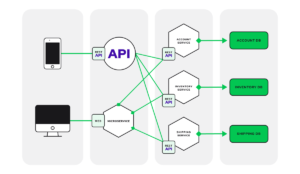In recent years, microservices architecture has gained immense popularity among developers and organizations looking to build scalable, resilient, and flexible software systems. At the same time, Spring Boot has emerged as a leading framework for building Java-based applications with ease and speed. When combined, Spring Boot and microservices architecture form a powerful duo, offering developers a robust platform for building modern, cloud-native applications. In this article, we’ll explore why Spring Boot and microservices architecture are a perfect match and how they work together to enable efficient development and deployment of distributed systems.
Understanding Microservices Architecture
Microservices architecture is an architectural style that structures an application as a collection of loosely coupled, independently deployable services. Each service is responsible for a specific business capability and communicates with other services through lightweight protocols such as HTTP or messaging queues. Microservices promote autonomy, scalability, and resilience by allowing teams to develop, deploy, and scale individual services independently.
Introduction to Spring Boot
Spring Boot, part of the broader Spring ecosystem, is an opinionated framework that simplifies the development of production-ready Java applications. It provides a convention-over-configuration approach, auto-configuration, and starter dependencies, allowing developers to quickly set up and bootstrap Spring-based projects with minimal configuration. Spring Boot promotes rapid development, developer productivity, and operational efficiency by reducing boilerplate code and eliminating complex configuration.
Why Spring Boot and Microservices Are a Perfect Match
- Ease of Development: Spring Boot’s intuitive programming model and built-in features such as auto-configuration and dependency injection make it easy to develop and maintain microservices-based applications. Developers can focus on writing business logic without worrying about infrastructure concerns.
- Modularity and Scalability: Spring Boot encourages modularity and separation of concerns, enabling developers to build and scale microservices independently. Each microservice can be developed, tested, and deployed as a self-contained unit, allowing for faster iteration and continuous delivery.
- Integration with Spring Ecosystem: Spring Boot seamlessly integrates with other Spring projects and libraries, such as Spring Cloud, Spring Data, and Spring Security, providing developers with a comprehensive set of tools for building microservices-based applications. Spring Cloud offers features for service discovery, distributed configuration, circuit breaking, and more, facilitating the implementation of microservices architectural patterns.
- Cloud-Native Capabilities: Spring Boot’s support for cloud-native development enables developers to build applications that are optimized for deployment in cloud environments. Features such as health checks, metrics, and externalized configuration make it easy to monitor, manage, and scale microservices in cloud-native architectures.
Best Practices for Building Microservices with Spring Boot
- Domain-Driven Design (DDD): Adopt domain-driven design principles to identify and define bounded contexts, aggregates, and domain models for each microservice, ensuring a clear separation of concerns and a cohesive design.
- Containerization and Orchestration: Use containerization tools like Docker and container orchestration platforms like Kubernetes to package, deploy, and manage microservices at scale, ensuring portability and resilience.
- API Gateway and Service Mesh: Implement an API gateway for routing and aggregating requests to microservices, and consider using a service mesh for managing service-to-service communication, load balancing, and observability.
- Continuous Integration and Deployment (CI/CD): Implement CI/CD pipelines for automated testing, building, and deploying microservices, enabling rapid and reliable delivery of new features and updates to production environments.
Conclusion
In conclusion, Spring Boot and microservices architecture complement each other seamlessly, offering developers a powerful and efficient platform for building modern, cloud-native applications. With Spring Boot’s ease of development, modularity, and integration with the Spring ecosystem, combined with the scalability, resilience, and flexibility of microservices architecture, developers can accelerate the development lifecycle, respond to changing business requirements, and deliver value to users more effectively. By leveraging Spring Boot and microservices, organizations can embrace digital transformation, innovate faster, and stay competitive in today’s rapidly evolving technology landscape.





